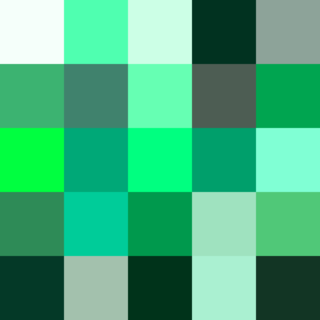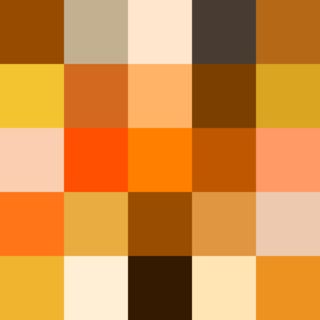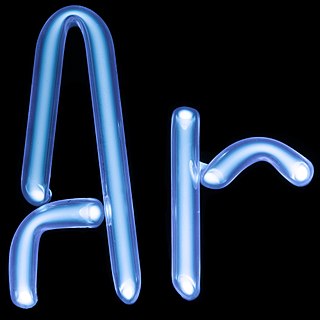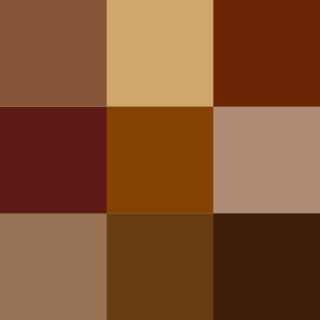
Navy blue is a dark shade of the color blue.
Powder blue is a pale shade of blue. As with most colours, there is no absolute definition of its exact hue. Originally, powder blue, in the 1650s, was powdered smalt used in laundering and dyeing applications, and it then came to be used as a colour name from 1894.

Grey or gray is an intermediate color between black and white. It is a neutral or achromatic color, meaning literally that it is "without color", because it can be composed of black and white. It is the color of a cloud-covered sky, of ash, and of lead.

Olive is a dark yellowish-green color, like that of unripe or green olives.

Spring green is a color that was traditionally considered to be on the yellow side of green, but in modern computer systems based on the RGB color model is halfway between cyan and green on the color wheel.
Royal blue is a deep and vivid shade of blue. It is said to have been created by a consortium of mills in Rode, Somerset, which won a competition to make a robe for Queen Charlotte, consort of King George III. In winning the prize, a business in the village invented the dye and received a certificate to sell it under that name.
Payne's grey is a dark blue-grey colour used in painting. Originally a mixture of iron blue, yellow ochre and crimson lake, Payne's grey now is often a mixture of blue and black, or of ultramarine and burnt sienna. The colour is named after William Payne, who painted watercolours in the late 18th century, who most likely developed the colour while trying to produce a mixer that was less intense than black. Payne's grey was deemed an obsolete term in the early 19th century, but is still used by artists today.

Raspberry is a color that resembles the color of raspberries.

In optics, orange has a wavelength between approximately 585 and 620 nm and a hue of 30° in HSV color space. In the RGB color space it is a secondary color numerically halfway between gamma-compressed red and yellow, as can be seen in the RGB color wheel. The complementary color of orange is azure. Orange pigments are largely in the ochre or cadmium families, and absorb mostly blue light.

Electric blue is a color whose definition varies but is often considered close to cyan, and which is a representation of the color of lightning, an electric spark, and the color of ionized argon gas; it was originally named after the ionized air glow produced during electrical discharges, though its meaning has broadened to include shades of blue that are metaphorically "electric" by virtue of being "intense" or particularly "vibrant". Electric arcs can cause a variety of color emissions depending on the gases involved, but blue and purple are typical colors produced in the troposphere where oxygen and nitrogen dominate.

Varieties of the color green may differ in hue, chroma or lightness, or in two or three of these qualities. Variations in value are also called tints and shades, a tint being a green or other hue mixed with white, a shade being mixed with black. A large selection of these various colors is shown below.

Varieties of the color red may differ in hue, chroma or lightness, or in two or three of these qualities. Variations in value are also called tints and shades, a tint being a red or other hue mixed with white, a shade being mixed with black. A large selection of these various colors are shown below.
Cinereous is a colour, meaning ashy grey in appearance, either consisting of or resembling ashes, or a grey colour tinged with coppery brown. It is derived from the Latin cinereus, from cinis (ashes).
Livid is a medium bluish-gray color. This color name comes from the Latin color term lividus meaning "'a dull leaden-blue color', and also used to describe the color of contused flesh, leading to the English expression 'black and blue'". The first recorded use of livid as a color name in English was in 1622.

Varieties of the color blue may differ in hue, chroma, or lightness, or in two or three of these qualities. Variations in value are also called tints and shades, a tint being a blue or other hue mixed with white, a shade being mixed with black. A large selection of these colors is shown below.

Shades of white are colors that differ only slightly from pure white. Variations of white include what are commonly termed off-white colors, which may be considered part of a neutral color scheme.

Variations of gray or grey include achromatic grayscale shades, which lie exactly between white and black, and nearby colors with low colorfulness. A selection of a number of these various colors is shown below.

The color cyan, a greenish-blue, has notable tints and shades. It is one of the subtractive primary colors along with magenta, and yellow.

There are numerous variations of the color purple, a sampling of which is shown below.

Shades of brown can be produced by combining red, yellow, and black pigments, or by a combination of orange and black—illustrated in the color box. The RGB color model, that generates all colors on computer and television screens, makes brown by combining red and green light at different intensities. Brown color names are often imprecise, and some shades, such as beige, can refer to lighter rather than darker shades of yellow and red. Such colors are less saturated than colors perceived to be orange. Browns are usually described as light or dark, reddish, yellowish, or gray-brown. There are no standardized names for shades of brown; the same shade may have different names on different color lists, and sometimes one name can refer to several very different colors. The X11 color list of web colors has seventeen different shades of brown, but the complete list of browns is much longer.





